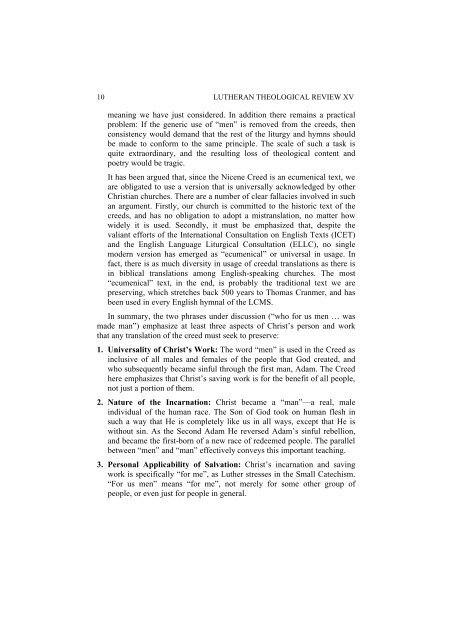LUTHERAN THEOLOGICAL REVIEW - Brock University
LUTHERAN THEOLOGICAL REVIEW - Brock University
LUTHERAN THEOLOGICAL REVIEW - Brock University
You also want an ePaper? Increase the reach of your titles
YUMPU automatically turns print PDFs into web optimized ePapers that Google loves.
10 <strong>LUTHERAN</strong> <strong>THEOLOGICAL</strong> <strong>REVIEW</strong> XV<br />
meaning we have just considered. In addition there remains a practical<br />
problem: If the generic use of “men” is removed from the creeds, then<br />
consistency would demand that the rest of the liturgy and hymns should<br />
be made to conform to the same principle. The scale of such a task is<br />
quite extraordinary, and the resulting loss of theological content and<br />
poetry would be tragic.<br />
It has been argued that, since the Nicene Creed is an ecumenical text, we<br />
are obligated to use a version that is universally acknowledged by other<br />
Christian churches. There are a number of clear fallacies involved in such<br />
an argument. Firstly, our church is committed to the historic text of the<br />
creeds, and has no obligation to adopt a mistranslation, no matter how<br />
widely it is used. Secondly, it must be emphasized that, despite the<br />
valiant efforts of the International Consultation on English Texts (ICET)<br />
and the English Language Liturgical Consultation (ELLC), no single<br />
modern version has emerged as “ecumenical” or universal in usage. In<br />
fact, there is as much diversity in usage of creedal translations as there is<br />
in biblical translations among English-speaking churches. The most<br />
“ecumenical” text, in the end, is probably the traditional text we are<br />
preserving, which stretches back 500 years to Thomas Cranmer, and has<br />
been used in every English hymnal of the LCMS.<br />
In summary, the two phrases under discussion (“who for us men … was<br />
made man”) emphasize at least three aspects of Christ’s person and work<br />
that any translation of the creed must seek to preserve:<br />
1. Universality of Christ’s Work: The word “men” is used in the Creed as<br />
inclusive of all males and females of the people that God created, and<br />
who subsequently became sinful through the first man, Adam. The Creed<br />
here emphasizes that Christ’s saving work is for the benefit of all people,<br />
not just a portion of them.<br />
2. Nature of the Incarnation: Christ became a “man”—a real, male<br />
individual of the human race. The Son of God took on human flesh in<br />
such a way that He is completely like us in all ways, except that He is<br />
without sin. As the Second Adam He reversed Adam’s sinful rebellion,<br />
and became the first-born of a new race of redeemed people. The parallel<br />
between “men” and “man” effectively conveys this important teaching.<br />
3. Personal Applicability of Salvation: Christ’s incarnation and saving<br />
work is specifically “for me”, as Luther stresses in the Small Catechism.<br />
“For us men” means “for me”, not merely for some other group of<br />
people, or even just for people in general.













